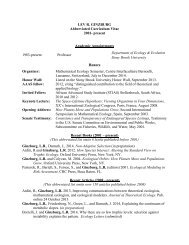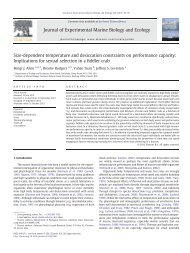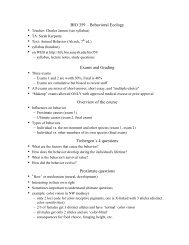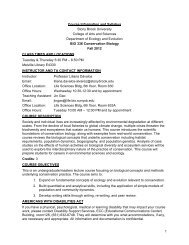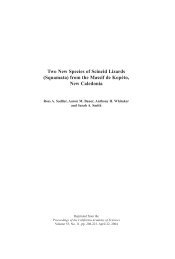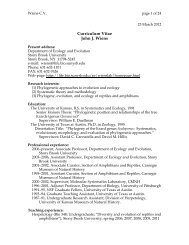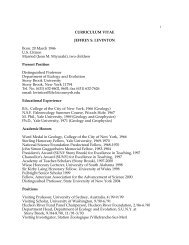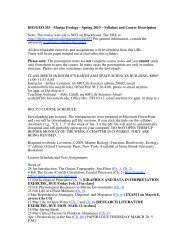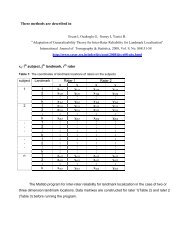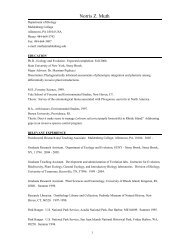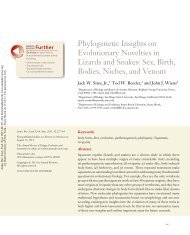Geometric morphometrics simplified - Stony Brook University
Geometric morphometrics simplified - Stony Brook University
Geometric morphometrics simplified - Stony Brook University
You also want an ePaper? Increase the reach of your titles
YUMPU automatically turns print PDFs into web optimized ePapers that Google loves.
<strong>Geometric</strong> <strong>morphometrics</strong> <strong>simplified</strong><br />
<strong>Geometric</strong> Morphometrics for Biologists: A Primer by Miriam Leah Zelditch, Donald L. Swiderski, H. David Sheets and<br />
William L. Fink, Elsevier Academic Press, 2004. £44.95 hbk (443 pages)<br />
ISBN 0127784608<br />
F. James Rohlf<br />
Department of Ecology and Evolution, State <strong>University</strong> of New York, <strong>Stony</strong> <strong>Brook</strong>, NY 11794-5245, USA<br />
Although the theory and methods of the<br />
relatively new field of geometric <strong>morphometrics</strong><br />
are becoming well developed<br />
(for an overview, see [1]), it has<br />
not yet been applied as widely as it<br />
could be, owing to the lack of easily<br />
accessible introductory guides. This<br />
primer, by Miriam Zelditch and colleagues,<br />
should make the field more<br />
accessible because the new methods described here are<br />
relatively simple to apply using currently available software.<br />
<strong>Geometric</strong> Morphometrics for Biologists contains<br />
chapters that cover most of the basic topics that a<br />
potential user needs to know to collect data in an<br />
appropriate format and to use standard multivariate<br />
methods for the analysis and interpretation of shape<br />
variation.<br />
The authors provide simple step-by-step (‘click by<br />
click’) tutorials on the use of morphometric software,<br />
starting with the use of the tpsDig software [2] to<br />
collect 2D landmark coordinate data and then discussing<br />
the use of the many programs in the IMP series [3]<br />
to carry out various analyses. In addition to specialized<br />
morphometric methods, the authors also discuss<br />
significance testing, resampling methods and other<br />
basic statistical methods (however, there are problems<br />
with their descriptions of confidence intervals and<br />
their relationships to tests of significance). The book<br />
also includes chapters about disparity and variation,<br />
ontogeny and phylogeny, and <strong>morphometrics</strong> and<br />
systematics. These include some detailed examples<br />
and suggestions of new methods (not all of which I<br />
agree with). There are exercises with answers at the<br />
end of most chapters and a glossary of concepts and<br />
terms. A limitation of the book is that methods for 3D<br />
data and the use of semi-landmarks along curves and<br />
surfaces are relegated to the last chapter. Although the<br />
acquisition of 3D coordinate data is more difficult that<br />
for 2D data and can require more-expensive equipment,<br />
it is now becoming standard in fields such as<br />
physical anthropology and primatology and is likely to<br />
become more common in the future.<br />
Unfortunately, the book is uneven in its presentation.<br />
Some concepts are described in such a way that little<br />
mathematical background is required, whereas others<br />
assume more sophisticated knowledge. For example,<br />
Corresponding author: Rohlf, F.J. (rohlf@life.bio.sunysb.edu).<br />
www.sciencedirect.com<br />
Update TRENDS in Ecology and Evolution Vol.20 No.1 January 2005 13<br />
Bookstein shape coordinates are described in great<br />
detail (over 20 pages) in terms of simple geometric<br />
operations. However, Bookstein’s estimate of the uniform<br />
component [4] is derived in detail using complex<br />
variables (an approach that does not generalize for use<br />
with 3D data).<br />
There are also problems in the presentation of some<br />
of the theoretical material that might confuse a careful<br />
reader. Although much of their description of Kendall’s<br />
shape space is clear, there are problems with some of<br />
the authors’ descriptions of the relationships between<br />
the hemisphere of preshapes aligned to a reference and<br />
Kendall’s shape space. For example, they indicate that<br />
the equator of the hemisphere for triangles aligned<br />
using an equilateral triangle as a reference corresponds<br />
to co-linear triangles (in reality, it corresponds<br />
to the single shape that is most different from the<br />
reference – a reflected equilateral triangle) and that<br />
the ‘bottom half ’ of Kendall’s shape space for triangles<br />
corresponds to just reflections and can, therefore, be<br />
ignored (unfortunate advice because real shape differences<br />
might correspond to shapes that look like<br />
reflections [5]). The authors also indicate that one<br />
will get precisely the same results when testing for<br />
differences in mean shape whether using multivariate<br />
tests based on partial warp scores or by using Goodall’s<br />
F-test. This is unlikely in practice because the<br />
partial warp scores procedure is based on a linear<br />
approximation to Kendall’s shape space, whereas Goodall’s<br />
F-test is based on Procrustes distances in the curvilinear<br />
space and, more importantly, on the unreasonable<br />
assumption that the variation across landmarks is<br />
homogeneous and uncorrelated and, thus, can lead to<br />
very different results.<br />
There are other more minor problems. The book does<br />
not follow the usual conventions of using italics for scalars,<br />
lowercase bold for vectors and uppercase bold for matrices,<br />
and the symbol hXi is used for the expected value (mean)<br />
of X. The use of such symbols makes the book more<br />
difficult to read. There are also several disconcerting typos<br />
(e.g. incorrect degrees of freedom for t-tests, and omissions<br />
in some equations).<br />
In spite of these problems, <strong>Geometric</strong> Morphometrics<br />
for Biologists (which is likely to become known in the field<br />
as the ‘green book’) is an important contribution. I am<br />
looking forward to an increase in interest in the field as a<br />
result of its publication.
14<br />
Update TRENDS in Ecology and Evolution Vol.20 No.1 January 2005<br />
References<br />
1 Adams, D.C. et al. (2004) <strong>Geometric</strong> <strong>morphometrics</strong>: ten years of<br />
progress following the ‘revolution’. Ital. J. Zool. 71, 5–16<br />
2 Rohlf, F.J. (2004) tpsDig, (http://life.bio.sunysb.edu/morph/)<br />
3 Sheets, H.D. (2004) IMP, Integrated Morphometrics Package, (http://<br />
www2.canisius.edu/~sheets/morphsoft.html)<br />
4 Bookstein, F.L. (1996) A standard formula for the uniform shape<br />
component in landmark data. In Advances in Morphometrics (Marcus,<br />
L.F. et al., eds), pp. 153–168, Plenum<br />
5 Rohlf, F.J. (1996) Morphometric spaces, shape components and the<br />
effects of linear transformations. In Advances in Morphometrics<br />
(Marcus, L.F. et al., eds), pp. 117–129, Plenum<br />
0169-5347/$ - see front matter Q 2004 Elsevier Ltd. All rights reserved.<br />
doi:10.1016/j.tree.2004.08.005



